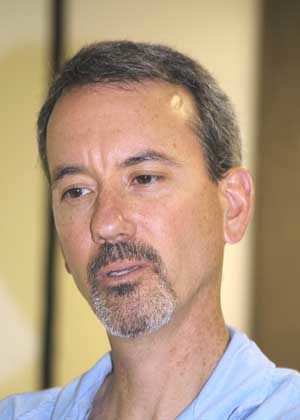A mere handful of soil taken from right around the roots of a tree may hold the fruit industry’s biggest mysteries.
That’s why the rhizosphere — this complex zone of millions of microorganisms in a single gram — is next up for an endowed chair position to be hired by Washington State University.
“It’s the biggest hole I see left in our knowledge about tree fruit,” said Mike Robinson, a partner in Double Diamond Fruit in Quincy, Washington, and member of WSU’s search committee.

David Brown
The university is on its third search for a soil and rhizosphere ecology endowed chair.
When filled, the specialist would be the second endowed chair related to the university’s $32 million tree fruit endowment, WSU’s largest financial gift ever, and based at the Tree Fruit Research and Extension Center in Wenatchee.
The first was Stefano Musacchi, a research horticulturist based at the same center.
Endowed chairs, by necessity, take a long time to hire. They are reserved for some of the world’s leading experts in a field, many of them married to other highly skilled scientists who want a job.
The competition is especially fierce for this hot field right now, too. Colorado State University, Michigan State University, Pennsylvania State University and several U.S. Department of Agriculture locations have made recruiting efforts for soil specialists in the past year or so.
The complex interactions between plant roots and the soil around them could lead to breakthroughs in disease management and nutrient uptake if they were better understood, Robinson said. He calls the industry’s understanding of soil 30 or 40 years behind that of, say, entomology.
“That’s why this has been a priority for the research commission for so long,” he said.
Washington isn’t the only state curious about soil and roots, however.
Greg Peck, a Cornell University professor of plant science, also has research projects dedicated to the interaction of microbes and tree roots. He sees a day when those microbes could be manipulated to, say, prevent replant disease without expensive and ecologically destructive fumigation or reduce dependence on nitrogen applications.
“We’re just learning a tremendous amount about it,” Peck said.
In Washington, Mark Mazzola, a U.S. Department of Agriculture plant pathologist, also in Wenatchee, has done some of the most well-known soil research as it relates to orchards so far. (Read “Searching for the naked truth about soil science.”)
Part of the mystery of soil is not just that it’s underground, Mazzola said, but it’s so mind-bogglingly complex. The area just inches away from the roots of a tree contain an intricate array of amino acids, carbon compounds and sugars released by the plant through its roots that intertwine in ways with fungi and bacteria that science has yet to fully understand.
“You can have so many different interactions,” Mazzola said.
Breakthroughs in genetics have allowed Mazzola and researchers to begin identifying organisms in the rhizosphere. However, many of their nutritional needs are still unknown, so they’re hard to grow in a lab culture.
Thus, how they behave is still mysterious. “Identifying (an organism) is one thing,” Mazzola said. “Identifying what it does is a whole different story.”
In contrast, catch a few bugs and you simply watch what they do, he said.
Unfortunately for tree fruit growers, soil science has usually been a discipline under the banner of agronomy and row crops, and research there doesn’t always translate to an orchard setting, said David Brown, a soil science professor for WSU in Pullman and head of the search team for the endowed chair. Even Brown has spent most of his working years on wheat in Eastern Washington.
However, it’s high time to start answering some questions about soil and fruit trees, he said.
“Understanding what the microbes are doing is fundamental to understanding why some orchards suffer from replant disease and others don’t,” he said. “Why some respond to certain organic treatments and others do not; why a rootstock might perform well in some soils and climates, but not others; why a nutrient application might be much more efficacious in one soil than another.” •
– by Ross Courtney






Leave A Comment